人教版小学二年级英语教案
2024小学英语二年级人教版下册《My Neighbourhood》教案
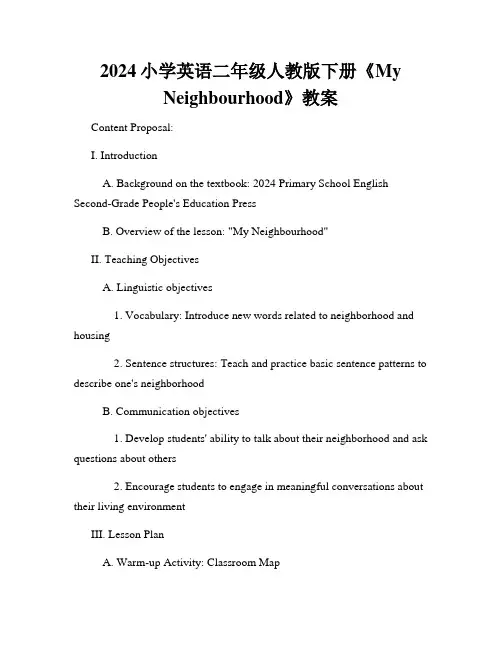
2024小学英语二年级人教版下册《MyNeighbourhood》教案Content Proposal:I. IntroductionA. Background on the textbook: 2024 Primary School English Second-Grade People's Education PressB. Overview of the lesson: "My Neighbourhood"II. Teaching ObjectivesA. Linguistic objectives1. Vocabulary: Introduce new words related to neighborhood and housing2. Sentence structures: Teach and practice basic sentence patterns to describe one's neighborhoodB. Communication objectives1. Develop students' ability to talk about their neighborhood and ask questions about others2. Encourage students to engage in meaningful conversations about their living environmentIII. Lesson PlanA. Warm-up Activity: Classroom Map1. Display a large map of a generic neighborhood on the board2. Ask students to point out different places on the map3. Facilitate discussion by asking questions like "Where is the post office?"B. Presentation: Vocabulary Introduction1. Introduce new vocabulary words related to neighborhood and housing, such as "school," "park," "house," etc.2. Use flashcards or visual aids to help students understand and remember the wordsC. Practice: describing one's neighborhood1. Model a simple sentence to describe your neighborhood, e.g., "I live near a park."2. Have students take turns describing their own neighborhood using the new vocabularyD. Group Activity: My Dream Neighborhood1. Divide the class into small groups2. Provide each group with drawing materials and ask them to design their dream neighborhood3. Encourage students to use as many new vocabulary words as possible in their descriptionsE. Pair work: Interviewing a Classmate1. Pair up students and instruct them to interview each other about their neighborhoods2. Encourage the use of question words like "Where," "What," and "How" to facilitate conversationF. Wrap-up Activity: Class Presentation1. Ask some pairs to share interesting facts they learned about their classmates' neighborhoods2. Provide feedback and praise for the students' effort and participationIV. AssessmentA. Observation and Participation: Monitor students' engagement throughout the lessonB. Verbal Assessment: Evaluate students' ability to use new vocabulary and sentence structures during pair workC. Peer Assessment: Encourage students to give constructive feedback to their peers during the class presentationV. ConclusionA. Recap the main objectives of the lesson: vocabulary acquisition and speaking skills developmentB. Highlight the importance of knowing and appreciating one's neighborhoodC. Encourage students to explore and learn more about their local communityPlease note that this content proposal is just a sample structure for the teaching plan. You may add more details, resources, or adapt the content to suit your specific needs.。
最新人教版小学二年级英语上册教案全册
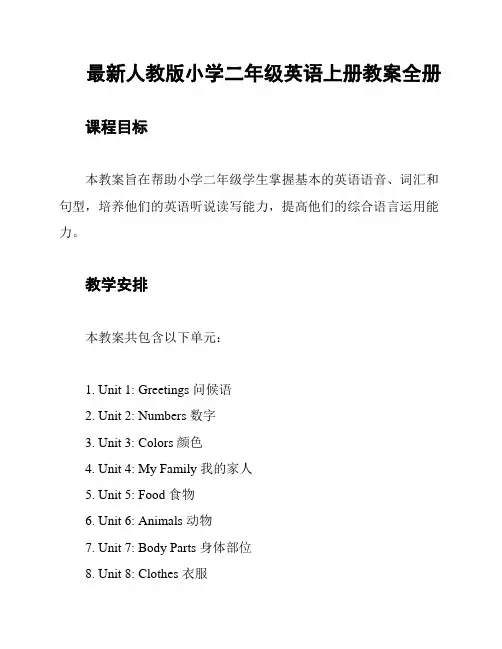
最新人教版小学二年级英语上册教案全册
课程目标
本教案旨在帮助小学二年级学生掌握基本的英语语音、词汇和句型,培养他们的英语听说读写能力,提高他们的综合语言运用能力。
教学安排
本教案共包含以下单元:
1. Unit 1: Greetings 问候语
2. Unit 2: Numbers 数字
3. Unit 3: Colors 颜色
4. Unit 4: My Family 我的家人
5. Unit 5: Food 食物
6. Unit 6: Animals 动物
7. Unit 7: Body Parts 身体部位
8. Unit 8: Clothes 衣服
9. Unit 9: Daily Routines 日常活动
10. Unit 10: Weather 天气
每个单元的教学内容包括基本单词、句子和语法知识,并通过听、说、读、写等多种方式进行教学。
教学方法
1. 教师引导学生观看课件、听音频和进行角色扮演等情境实践,以提高学生的听说能力。
2. 教师以游戏、歌曲等活动形式激发学生的积极性,增加研究
的趣味性。
3. 教师通过读物、练册等适当的阅读材料,培养学生的阅读理
解和写作能力。
评估方法
1. 每个单元结束后进行小测验,检查学生对所学知识的掌握情况。
2. 定期进行口语表达和书面表达的综合评估,全面了解学生的英语水平发展情况。
教学资源
1. 人教版小学二年级英语教材及配套教辅资料。
2. 课堂课件、音频和视频素材。
3. 各单元的练册和阅读材料。
以上是最新人教版小学二年级英语上册教案的概述,希望可以帮助到您的教学工作。
人教版英语二年级上册教案
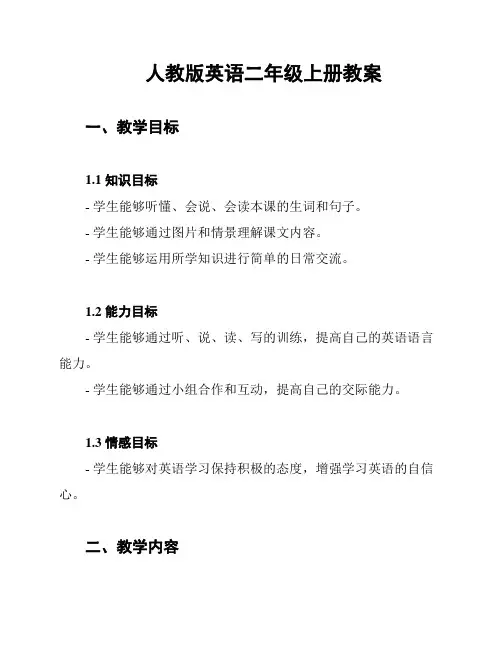
人教版英语二年级上册教案一、教学目标1.1 知识目标- 学生能够听懂、会说、会读本课的生词和句子。
- 学生能够通过图片和情景理解课文内容。
- 学生能够运用所学知识进行简单的日常交流。
1.2 能力目标- 学生能够通过听、说、读、写的训练,提高自己的英语语言能力。
- 学生能够通过小组合作和互动,提高自己的交际能力。
1.3 情感目标- 学生能够对英语学习保持积极的态度,增强学习英语的自信心。
二、教学内容2.1 教材内容- 课文:人教版英语二年级上册第二单元。
- 句子:This is our classroom. This is a desk. This is a chair. etc.2.2 教学内容解析本节课主要通过学习生词和句子,让学生熟悉教室里的物品和人物,提高学生的听说读写能力。
三、教学方法3.1 教学手段- 图片展示:通过展示教室里的物品和人物的图片,帮助学生理解和记忆。
- 情景模拟:通过模拟教室里的情景,让学生真实地感受和运用所学知识。
- 小组合作:通过小组合作和互动,提高学生的交际能力和团队合作能力。
3.2 教学策略- 全身反应法:通过身体动作和表情,让学生更好地理解和记忆。
- 任务型教学法:通过完成具体的任务,让学生将所学知识应用到实际中。
四、教学步骤4.1 热身(5分钟)- 教师与学生进行简单的英语对话,检查学生的英语水平。
4.2 呈现(10分钟)- 教师通过展示教室里的物品和人物的图片,引入本节课的主题。
- 教师用英语介绍教室里的物品和人物,学生跟读。
4.3 练习(10分钟)- 教师模拟教室里的情景,让学生进行角色扮演,运用所学知识。
- 学生进行小组合作,用英语讨论教室里的物品和人物。
4.4 巩固(10分钟)- 教师给出一些关于教室里的物品和人物的问题,学生用英语回答。
- 学生进行听力练习,听懂并重复所听到的句子。
4.5 总结(5分钟)- 教师对本节课的内容进行总结,强调重点和难点。
人教版小学二年级上册英语全册教案
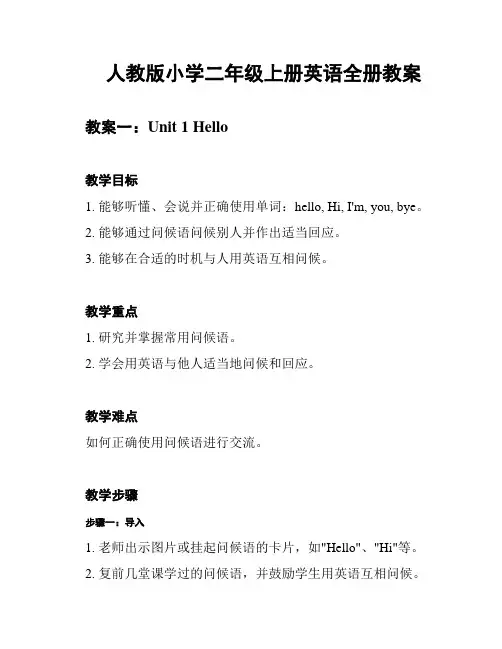
人教版小学二年级上册英语全册教案教案一:Unit 1 Hello
教学目标
1. 能够听懂、会说并正确使用单词:hello, Hi, I'm, you, bye。
2. 能够通过问候语问候别人并作出适当回应。
3. 能够在合适的时机与人用英语互相问候。
教学重点
1. 研究并掌握常用问候语。
2. 学会用英语与他人适当地问候和回应。
教学难点
如何正确使用问候语进行交流。
教学步骤
步骤一:导入
1. 老师出示图片或挂起问候语的卡片,如"Hello"、"Hi"等。
2. 复前几堂课学过的问候语,并鼓励学生用英语互相问候。
步骤二:讲解
1. 老师用英语示范常见的问候语,例如"Hello"、"Hi"。
2. 教师将这些问候语的中文意思进行解释,并示范学生正确的发音。
步骤三:练
1. 学生之间进行分组练,通过问候语互相问好,并逐渐增加英文单词的难度。
2. 教师可以模拟一些情境,比如问候同学、老师或其他人,在学生中进行角色扮演的练。
步骤四:总结
1. 教师带领学生总结本节课研究的内容,强调正确使用问候语的重要性。
2. 鼓励学生在课下积极运用所学知识进行实践。
教学延伸
1. 将学生分为小组,组织问候比赛,看哪个小组能够最快速、准确地回答。
2. 将问候语与动作结合,进行身体语言的讲解与练。
教学评价
教师可根据学生的表现进行口头评价,并通过学生练的结果进行书面评价。
注:本教案为参考教案,根据教材和学生实际情况进行适当调整。
人教版二年级上册英语全册教案

备课本人教版二年级上册英语全册教案班级______教师______日期______人教版二年级上册英语教案——Unit1教学目标教学目标1.能够在本单元涉及的情景条件下听懂并说出有关家庭及成员的7个单词和表示职业的2个单词。
2.能够在本单元涉及的情景条件下初步使用本单元所学的句型。
3.能够对家庭成员的姓名、年龄、性别、喜好及所从事的工作等基本情况进行简单介绍。
4.能够通过键盘操作,初步体验字母组成单词的过程。
5.通过开展丰富的课堂活动,激发学生学习英语的兴趣,培养他们英语听说的基本能力。
6.通过本单元的学习,使学生了解家庭成员间的基本关系,帮助学生逐渐养成尊老爱幼的传统美德。
人教版二年级上册英语教案——lesson1[标签:人教版二年级课文教案]课前准备1.教学挂图。
2.教学投影片。
3.教学录音磁带。
4.单词卡片。
5.学生的家庭合影照片。
教学内容A Let's chant.1.本部分利用生活实景图画引出7个有关家庭及成员的单词:family, grandpa, gra ndma, dad, mom, brother, sister。
2.学生借助图画和录音学习7个有关家庭及成员的单词。
3.歌谣和单词的录音材料为学生提供了规范的语音输入,便于学生模仿和正确朗读。
4.本课所选的表示“爸爸”、“妈妈”的英文单词是“dad”、“mom”。
在美国,此称呼在儿童口语中较“father”、“mother”更常见。
5.本部分的教学难点是:单词brother中th字母组合的发音。
教师在教学时要准确示范,引导学生认真观察后,再让学生初步模仿。
B Let's say.1.本部分与A部分共用一幅图画。
2.学生在A部分训练的基础上,进一步复习有关家庭成员的单词。
教学建议1.教师出示本课图片,请学生边看边听录音,让学生首先从听觉上和视觉上对新内容有一个感性认识。
2.教师出示教学卡片,带领学生说出单词;然后,请学生观察模仿图片上的家庭成员的动作,并说出单词。
2024小学英语二年级人教版下册《Healthy Eating》教案
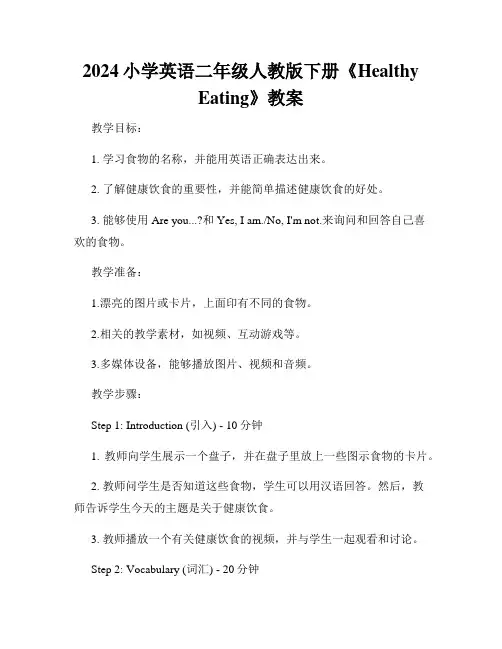
2024小学英语二年级人教版下册《HealthyEating》教案教学目标:1. 学习食物的名称,并能用英语正确表达出来。
2. 了解健康饮食的重要性,并能简单描述健康饮食的好处。
3. 能够使用Are you...?和Yes, I am./No, I'm not.来询问和回答自己喜欢的食物。
教学准备:1.漂亮的图片或卡片,上面印有不同的食物。
2.相关的教学素材,如视频、互动游戏等。
3.多媒体设备,能够播放图片、视频和音频。
教学步骤:Step 1: Introduction (引入) - 10分钟1. 教师向学生展示一个盘子,并在盘子里放上一些图示食物的卡片。
2. 教师问学生是否知道这些食物,学生可以用汉语回答。
然后,教师告诉学生今天的主题是关于健康饮食。
3. 教师播放一个有关健康饮食的视频,并与学生一起观看和讨论。
Step 2: Vocabulary (词汇) - 20分钟1. 教师向学生展示食物的图片或卡片,然后逐个教学生这些食物的英文名称。
2. 教师可以通过图片让学生感受不同食物的味道、形状和颜色,并引导学生用简单的英语表达这些感受。
例如,"This is a red apple. It tastes sweet."(这是一个红苹果。
它尝起来很甜。
)3. 学生个人或小组练习:- 学生可以用已学的食物词汇来描述自己喜欢的食物,并与同学分享。
- 学生也可以根据图片选择自己喜欢的食物,并用英语回答教师的问题。
例如,"Are you like ...? Yes, I am./No, I'm not."(你喜欢...吗?是的,我喜欢。
/不,我不喜欢。
)Step 3: Healthy Eating (健康饮食) - 30分钟1. 教师向学生介绍关于健康饮食的基本概念,并为学生提供一些简单的例子和解释。
2. 教师与学生一起讨论健康饮食的好处,例如保持健康、拥有更多的能量和更好的注意力等。
2024小学英语二年级人教版下册《Weather Talk》教案
2024小学英语二年级人教版下册《WeatherTalk》教案一、教材分析:《Weather Talk》是小学二年级英语下册的一篇教材,主要围绕天气预报展开,旨在帮助学生学会描述天气、询问天气和回答天气问题。
通过学习本篇课文,学生们可以提高自己的口语交际能力,同时也了解了日常生活中天气的变化和对生活的影响。
二、教学目标:1. 学会掌握描述天气的词汇和表达方式;2. 能够用正确的方式询问和回答天气问题;3. 提高学生的口语交际能力,培养学生的听说能力。
三、教学重点和难点:1. 重点:天气的基本描述词汇和句型;2. 难点:运用所学的词汇和句型进行实际对话并进行天气的描述。
四、教学准备:教师:教材P20的课文、图片、PPT;学生:英语课本、练习本。
五、教学过程:Step 1: Warm-up (热身)1. Greetings: Good morning/afternoon, class!/How are you today?2. Sing a weather song together: "How's the Weather?"(调侃天气).Step 2: Presentation (展示)1. Show some pictures of different weather conditions (sunny, rainy, windy, snowy) and ask students to identify them.2. Introduce the new vocabulary and phrases related to weather.(示意:教师通过图片和课件展示各种天气的图片,然后介绍和解释相关的词汇和短语,如“sunny, rainy, windy, snowy”等。
)Step 3: Practice (练习)1. Ask students to work in pairs and take turns asking and answering about the weather. Student A asks Student B "How's the weather today?" and Student B answers using the vocabulary learned.2. Teacher walks around the classroom and provides assistance and feedback as necessary.(示意:教师让学生两人一组自由操练对话,进行天气的问答练习。
二年级上册英语教案-《Revision1》(StoryTime)|人教(新起点)
二年级上册英语教案-《Revision 1》(Story Time)|人教(新起点)教学内容:本节课为《人教版新起点二年级上册英语》的教学内容,主题为《Revision 1》(Story Time)。
通过复习第一单元的内容,引导学生理解故事情节,并能用英语进行简单描述。
教学内容包括故事阅读、角色扮演、词汇复习和句型练习。
教学目标:1. 能听懂、会说、会读本节课的重点词汇和句型。
2. 能理解故事情节,并能用英语进行简单描述。
3. 培养学生的阅读兴趣和英语口语表达能力。
教学难点:1. 故事情节的理解和描述。
2. 重点词汇和句型的掌握。
教具学具准备:1. 教材《人教版新起点二年级上册英语》。
2. 投影仪、电脑、音响等教学设备。
3. 故事角色头饰、单词卡片等教具。
教学过程:1. 导入跟唱英文歌曲,营造英语学习氛围。
复习上节课学过的词汇和句型,为新课做好铺垫。
2. 故事阅读教师带领学生一起阅读《Revision 1》(Story Time)的故事,讲解生词和句型。
学生跟读,模仿语音语调。
3. 角色扮演分组进行角色扮演,让学生亲身体验故事情节。
鼓励学生用英语进行对话,提高口语表达能力。
4. 词汇复习通过游戏、竞赛等形式复习本单元的重点词汇。
巩固学生对词汇的记忆和理解。
5. 句型练习通过替换练习、问答等形式,让学生熟练掌握本节课的句型。
培养学生运用英语进行实际交流的能力。
布置作业,巩固所学知识。
板书设计:1. 故事《Revision 1》(Story Time)2. 重点词汇:单词卡片展示3. 句型:黑板板书作业设计:1. 抄写本节课的重点词汇和句型。
2. 根据故事情节,用英语进行简单描述。
3. 家长签字,监督孩子完成作业。
课后反思:1. 增加课堂互动,提高学生的参与度。
2. 对学生进行分层教学,关注个体差异。
3. 加强课后辅导,提高学生的学习效果。
重点关注的细节:教学过程的实施与互动1. 导入环节的设计选择一首与本课主题相关的英文歌曲,通过歌曲的旋律和歌词自然引入新课内容。
人教版小学二年级英语上册教案
二年级英语上册教案人教版h ing cedureI. warm-up1. Daily oral practiceT: Good morning !Ss: good morning!2. R eview the words.T: Show me the pen cil (ruler, book…)Ss: Liste n and do.II.Prese ntati onStep1.Part A1. T: Present the flash cards: “What' s this?Teach Ss to read the new words.2. Ask little teacher to lead Ss read the newwords.3. T: Say, Ss point and read after me. T pointSs look and say.4. Divide them into six groups.(grandpa,grandma,brother, sister, mom, dad)or S1say, team liste n and tap.T: Present the word cards, team read andtap.5. T: Write the chant on the blackboard,teach the n to read.6. Play the tape, listen and chant.Step2: PartB1. Ss: Look and read the sentences: I have <happy family.2. T: teach them to read, Study the words:me.3. Point and read.4. T and Ss: ask and answer. Listen to theTeachi ngcharacteristics:ah ing cedure I. warm-up1. Daily oral practice T: How are you? Ss: Fine, tha nk tyou!2. Review the words. T: Who is he/she?Ss: Liste n and an swer. II.Prese ntati onStep1.Part A1. T: Write the new senten ce:Who ishe/she? Teach Ss to read,2. C ha nt and match.Who s he ?Who s he?Dad, mom, family.Who s he?Who s she?Brother, sister, family.3. Read the words with jections. Say quicklyand quickly.4. T: Say. S1 do and say in Chi nese .Othersjudge yes or no.5. Set the situatio n to practise.6. P lay the tape, listen and read.7. Dialogue Step2: PartB Draw and talk.Liste n and draw.Teachi ngcharacteristics:h ing dure: Ss: What is he like?T: He is tall.En courage Ss to say.2.Work in pairs and draw.3.Show the pictures.Step2: PartB Let' si ng.We are classmates.We are frie nds.Bill, Andy and Lily.Binbin, Yaoyao and Joy.Every girl and every boy.Pretty, big or tall.Thin, short or small.We are frie nds and classmates all.h ing dure: Ss: Liste n to the tape, repeat.Practice in pairs.2. Do together.Step2: PartB Let' act1. Look at the picture and say.Joy, we have a new classmate, Ted.What's he like?He is tall.Bill, this is our new classmate Ted.Nice to meet you.Nice to meet you, too.Yaoyao, look! Who is he?He is our new classmate, Ted.2. Let' si ng.The moreweget together together, together. The more we get together.The happier we'll be.I help you. You help me.I help you. You help me.The more we get together.The happier we'll be!h ing dure: I.Warm up1. D aily oral practice. How are you?2. R eview the words: big tall pretty …II.Prese ntati onStep1:Part A Let ' s talk.Hi! I am Ted. I'm from Canada.Hi! I'm Joy. Nice to meet you.2. Teach the word: from Can ada3. Different ways to practise.4. Look at the pictures to practise.Step2: PartB Let's learn1.T:Prese nt the letters.Teach ss to read .2.Ss: Look and read.T:Point. Ss: Look and read.Teach incharactetics:h ing dure: 2. G ame: Hide and seakT: Hide the picture.S1: Look it for.Ss: Read the word.3. Play the tape.Ss: Liste n and cha nt.I see a hill.I see a bridge,In the beautiful park.I see a lake,In the beautiful park.The flowers are red.The grass is gree n.The trees are tall,In the beautiful, beautiful park.Step2: Liste n and draw.Hill! I draw a hill.There's a gree n tree on the hill.Look! There's a big lake and a long bridge.Oh! What beautiful red flowers, blue flowers and yellow flowers!h ing dure: I.Warm upI.Daily oral practice.T: What' s this?What colour is it?I. Review the words.Look and read.II. PresentationStep1:.Let's talk1. Read the senten ces.Teachthe new words: bee Butterfly.2. L et Ss read the senten ces.3. T explain the meaning.4. R ead after me.Read and do.4. Listen to the tape.What can you see in the picture?I can see ducks and boats.Step2:Let's act and say.T: What do you see?Ss: I see a tree.Guess the meaning accord ing to the body Ian guage.T: Guide Ss to understand it.Teach them to read and answer.Teach incharactetics:h ing dure: I.Warm up1. Daily oral practice.II. PresentationStep1:.Do and say.1.Ss: Read the story by themselves. Find out thewords about beautiful, bench to teach.2. L et s tell us the main meaning.3. T: Teach Ss to read the sentences.4. T; Play the tape.Ss: Liste n and read.How beautiful!Let's take a picture.Let's g boati ng.Great!Let's goLook, there is a bird in the tree.I can't see it.Sta nd on the ben ch.OK!Step2:.Let's talk about the pictures1. Ss: Read the sentence you can.2. Ss: Read in deskmates.Teach incharactetics:h ing dure: I.Warm upI. Daily oral practice.II. PresentationStep1:.F ind and talk1. T: Where is the duck?S: The duck is…2. Ss: Find out the words about animals. Readthem loudly, tell us the meaning.3. T:Ask them to find the animals out.4. Read and do.5. Play the tape, listen and read.Where is the dog?The dog is under the bridge.Where is the duck?The duck is on the lake.Where is the bird?The bird is in the grass.Where is the boy?The boy is behind the tree.Step2:.Let's lear n.1. Review the letters .2. Show then the flash cards, write the small let tersTeach incharactetics:h ing dure: 1. Riew the words: engineer, policeman, doctor,teacher.2. Riew the sentenses: Who is she? She is my mom. Who is he? He is my dad.3. D raw it out.Step2:.S ing and act1. T: Write the sentences on the board.Teach them to read.2. Listen to the tape.My mother is a teacher. Teach, teach, teach!My grandpa is a bus driver. Drive, drive, drive! My brother is a policeman. Stop, stop, stop.My grandma is an angineer. Build, build, build! My sister is a student. Learn, learn, learn!3. Sing toghter。
2024小学英语二年级人教版上册《Daily Routines》教案
2024小学英语二年级人教版上册《DailyRoutines》教案Daily Routines 教案教学目标:1. 学生能够掌握描述日常活动的常用英语表达。
2. 学生能够通过对话和练习,能够灵活运用所学的表达方式。
3. 学生能够培养良好的日常生活习惯,形成规律的作息时间。
教学步骤:一、导入(5分钟)教师可用图片或实物引入话题,让学生谈论自己的日常活动,并引导其使用英语表达。
二、练习活动(10分钟)教师可出示图片,并让学生配对每个图片对应的日常活动词汇,如brush teeth, eat breakfast, wear clothes等。
三、问答活动(15分钟)教师可以向学生提问相关的日常活动问题,如"What do you do in the morning?" "What do you do after school?" "What time do you go to bed?" 等,鼓励学生用英语回答。
四、听力训练(15分钟)教师播放一段描述日常活动的录音,提醒学生仔细聆听,然后回答问题。
五、对话练习(15分钟)教师提供对话模板,让学生自行编写并表演一段对话,描述他们的日常活动。
鼓励学生使用所学的词汇和句型。
六、口语操练(15分钟)教师分组让学生进行对话练习,每组学生相互询问对方的日常活动,并用英语回答。
教师可以通过听众评价的方式给予鼓励和指导。
七、巩固练习(15分钟)教师将学生分成小组,给每组学生一份练习题,让他们完成填空练习,补全日常活动的句子。
八、总结归纳(5分钟)教师带领学生总结所学的日常活动表达方式,并要求学生记住表达方式和习惯。
九、家庭作业(2分钟)布置家庭作业,要求学生写一篇关于自己日常活动的短文,并在作文中使用所学的词汇和句型。
教学反思:通过本节课的教学,学生掌握了描述日常活动的常用英语表达,能够使用所学的句型进行对话练习,并在情境中熟练运用。
- 1、下载文档前请自行甄别文档内容的完整性,平台不提供额外的编辑、内容补充、找答案等附加服务。
- 2、"仅部分预览"的文档,不可在线预览部分如存在完整性等问题,可反馈申请退款(可完整预览的文档不适用该条件!)。
- 3、如文档侵犯您的权益,请联系客服反馈,我们会尽快为您处理(人工客服工作时间:9:00-18:30)。
设计
Lesson 1
Who’s he/she?
He/she is…
教后
反思
滨海实验小学导学案模板
学科
英语
年级
二年级
执教人
郑亚萍
总第(3)课时
章节课题
Unit1 My Family
课时课题
Lesson 3
课型
新授课
课时
1
学习
目标
1.Learn how to use the words and the sentences that have learned in this unit.
达标
测试
Let students listen and say .
拓展
延伸
Role-play and say
盘点
收获
The student can read and understand the word and sentence
作业
Read the words for several times
板书
设计
Lesson 1
fathergrandfather
This is…mothergrandmother
brother
sister
教后
反思
2.Ask little teacher to lead Ss read the new words.
3.T: Say, Ss point and read after me. T point, Ss look and say.
4.Divide them into six groups.(grandpa, grandma,brother, sister, mom, dad)or S1 say, team listen and tap.
2.借助学过的词汇及相应的图片感知字母a,b,c,d在单词词首时常见的发音,并尝试借助图片和首字母提示整体识别单词。
学习
重点
3.Learn how to use the words and the sentences that have learned in this unit.
学习
难点
借助学过的词汇及相应的图片感知字母a,b,c,d在单词词首时常见的发音,并尝试借助图片和首字母提示整体识别单词
2.Let the students look at the pictures in part B carefully
3.Let them follow the tape to read the words and pay attention the pronunciation of a, b,c,d
2. Listen and chant again:
达标
测试
Let students listen and say .
拓展
延伸
Role-play and say
盘点
收获
The student can read and understand the word and sentence
作业
Read the words for several times
To learn the important sentences: Who’s he/she?
He /She is …
学习
难点
To learn the important sentences: Who’s he/she? He /She is …
课前
准备
CD and cards
教
学
过
程
一. warm-up
2.T: Say. S1 does and say in Chinese .Others judge yes or no.
3.. Set the situation to practice.
4..Play the , listen and read.
四.Practice
1.Role-play and say
T: Good morning !
Ss: good morning!
2.Review the words.
T: Show me the pencil (ruler, book…)
Ss: Listen and do.
二..Presentation
1.T: Present the flash cards:“What’s this?”Teach Ss to read the new words.
板书
设计
Lesson 1
fathergrandfather
This is…mothergrandmother
brother
sister
教后
反思
滨海实验小学导学案模板
学科
英语
年级
二年级
执教人
郑亚萍
总第(2)课时
章节课题
Unit1 My Family
课时课题
Lesson 2
课型
新授课
课时
1
学习
目标
To learn the important sentences: Who’s he/she? He /She is …
1.Daily oral practice
T: How are you?
Ss: Fine, thank you!
2.Review the last lesson
二.Presentation
Step1.Part A
1.T: Write the new sentence: Who is he/she? Teach Ss to read,
2. Listen and chant again:
达标
测试
Ask and answer in different ways
拓展
延伸
Role-play and say
盘点
收获
The student can read and understand the sentences
作业
Read the words for several times
学习
重点
To learn the new words :father,mother,brother,sister,grandfather
学习
难点
To learn the new sentence: This is…
课前
准备
CD and cards
教
学
过
程
一.Warm-up
1.Daily oral practice
课前
准备
CD and cards
教
学
过
程
一.Warm-up
1.Let student follow the tape to say and sing the ballad in lesson.
2. Review the word and the sentences that have learned in this unit.
T: Present the word cards, team read and tap.
5.T: Write the chant on the blackboard, teach then to read.
6.Play the tape, listen and chant。
三.Practice
1.Role-play and say
二.Presentation
1.大小写字母配对
教师在黑板上分别出示四个大写字母A,B,C,D和四个小写字母a,b,c,d在卡片,再画四所小房子,引导学生分别将四对大小写字母归入小房子。
T: Who’s the mother of the small letter“a”?
S:The big letter“A”
2.Chant and match.
Who’s he ?/Who’s he?
father, mother, grandfather.
Who’s he?/Who’s she?
grandmother brother, sister.
三.Consolidation
1. Read the words . Say quickly and quickly.
滨海实验小学导学案模板
学科
英语
年级
二年级
执教人
郑亚萍
总第(1)课时
章节课题
课时课题
课型
课时
学习
目标
1.To learn the new words :father,mother,brother,sister,grandfather,grandmother.
2.To learn the new sentence: This is…
